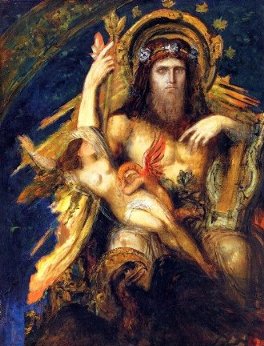



... It has taught us a new way of looking, of seeing, of perceiving and beholding. Now, through dreams, meditation, deep breathing, and a variety of other means - the gate to that higher world may once more be opened, and the image itself transcended.
Most of us take reading so for granted that we forget the Visionary states it may induce. It is not merely a question of imagining the worlds which words may conjure - although that too is a visionary act. As Gustave Moreau reminds us, "I am all the more for dreams, for phantasmagorias of the imagination which I bring to my reading, with its many tales of lost and far-off civilizations - a naïvité, an impulsive child-like acceptance of everything unbelievable. ...How else could we dream of India, of the forests of the New World, of fantastic islands in the Indian Ocean or antedeluvian flowers in the heart of Africa..."
As we read, words trigger images from our memory. But the simple word 'temple' for example, in all its emptiness and generality, may conjure up a whole series of specific memory-images in any one person - each image finely-detailed and described. Meanwhile, the very same word may evoke an entirely different series of memory-images in another person. Such is the power of the imagination. Where these two people begin to share their memory-images is at the level of art: actually building such a temple communally, or rendering it into a painted image recognizable to us all (and thus, a 'communal vision').
As we read, our art and imagination render into form those mysterious worlds which words describe.
The Symbolist movement emerged in France in the second half of the nineteenth century. It was based on ideas shared between both artists and literary figures. Those ideas shared were a rejection of Realism and Naturalism. Unlike their preceding generation they saw art as being subjective, ambiguous, and mysterious, and instead of looking outward into the world for their subject matter, it came from their emotions, dreams, and spiritual psyche.
The poet Jean Moreas first gave title to the movement in 1886,with his Symbolist Manifesto. He rejected the doctrines of Naturalism by novelist Emile Zola, and in his manifesto he singled out three poets as leading figures in the movement: Baudelaire, Mallarme, and Valery. Through their writings these poets supported and contributed to the Symbolist painter's success. Of the visual artists three stand out as the forerunners of Symbolism: Gustave Moreau, Pierre Puvis de Chavannes, and Odilon Redon. Puvis is known to be a precursor to the Symbolist movement, and although he never identified himself as a symbolist, and remained an independent artist, he was a great influence to the next generation of painters involved in the movement. He was quoted as saying, "I wish to be not Nature, but parallel to Nature."
Moreau and Redon were discovered by another crucial literary figure, Huysmans. He was another advocate of imagination and fantasy, and his book Against Nature published in 1884, he brings together the shared ideas between literary and visual artists. Moreau along with another artist Bresdin whose work as a printmaker would have a great influence upon Redon, stood out against the immersion of Naturalism in France during the 1860's and 1870's (the 1870's was the great decade of Impressionism).
Um comentário:
Hello. And Bye.
Postar um comentário